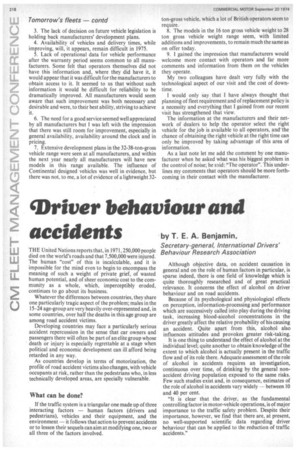'Driver behaviour and accidents
Page 220

If you've noticed an error in this article please click here to report it so we can fix it.
THE United Nations reports that, in 1971, 250,000 people died on the world's roads and that 7,500,000 were injured. The human "cost" of this is incalculable, and it is impossible for the mind even to begin to encompass the meaning of such a weight of private grief, of wasted human potential, and of sheer economic cost to the community as a whole, which, imperceptibly eroded, continues to go about its business.
Whatever the differences between countries, they share one particularly tragic aspect of the problem; males in the 15-24 age-group are very heavily over-represented and, in some countries, over half the deaths in this age group are among road accident victims.
Developing countries may face a particularly serious accident repercussion in the sense that car owners and passengers there will often be part of an elite group whose • death or injury is especially regrettable at a stage when political and economic development can ill afford being retarded in any way.
As countries develop in terms of motorization, the profile of road accident victims also changes, with vehicle occupants at risk, rather than the pedestrians who, in less technically developed areas, are specially vulnerable.
What can be done?
If the traffic system is a triangular one made up of three interacting factors — human factors (drivers and pedestrians), vehicles and their equipment, and the environment — it follows that action to prevent accidents or to lessen their sequels can aim at modifying one, two or all three of the factors involved.
by T. E. A.. Benjamin, Secretary-general, International Drivers' Behaviour Research Association
Although objective data, on accident causation in general and on the role of human factors in particular, is sparse indeed, there is one field of knowledge which is quite thoroughly researched and of great practical relevance. It concerns the effect of alcohol on driver behaviour and on road accidents.
Because of its psychological and physiological effects on perception, information-processing and performance which are successively called into play during the driving task, increasing blood-alcohol concentrations in the driver greatly affect the relative probability of his causing an accident. Quite apart from this, alcohol also influences attitudes and provokes greater risk-taking.
It is one thing to understand the effect of alcohol at the individual level; quite another to obtain knowledge of the extent to which alcohol is actually present in the traffic flow and of its role there, Adequate assessment of the role of alcohol in accidents requires an investigation, continuous over time, of drinking by the general nonaccident driving population exposed to the same risks. Few such studies exist and, in consequence, estimates of the role of alcohol in accidents vary widely between 10 and 40 per cent.
"It is clear that the driver, as the fundamental controlling factor in motor-vehicle operations, is of major importance to the traffic safety problem. Despite their importance, however, we find that there are, at present, no well-supported scientific data regarding driver behaviour that can be applied to the reduction of traffic accidents."




































































































































































































































































































































































